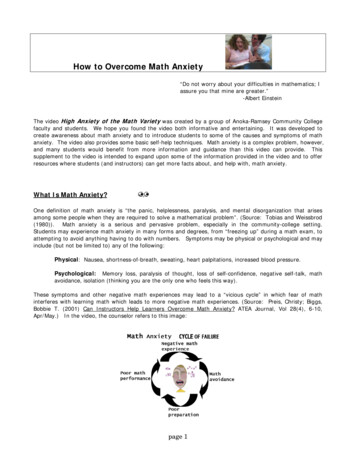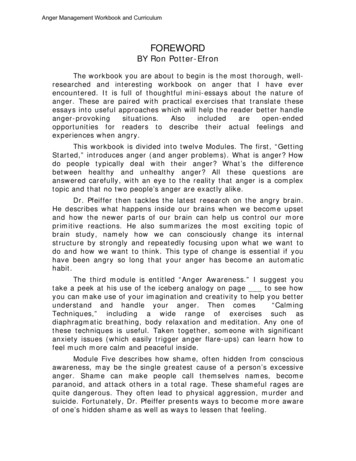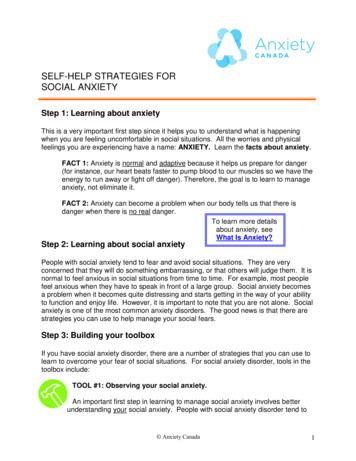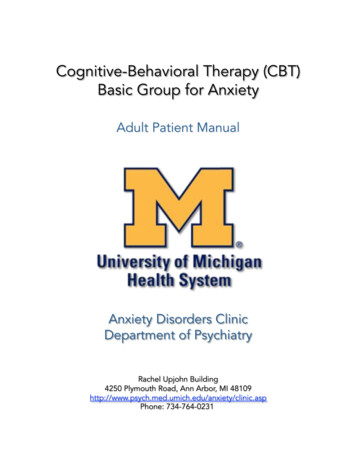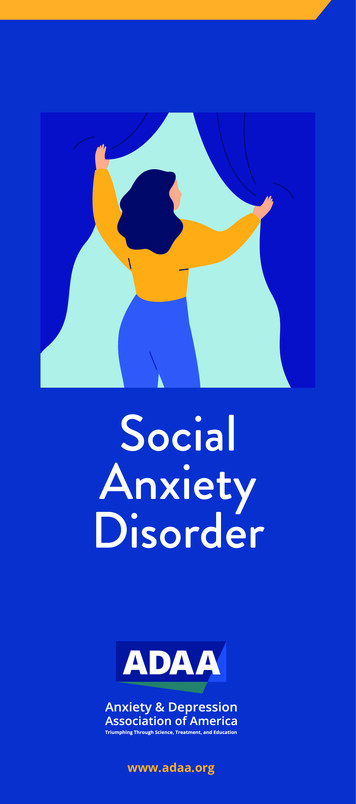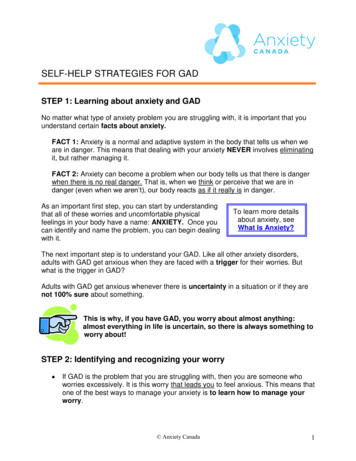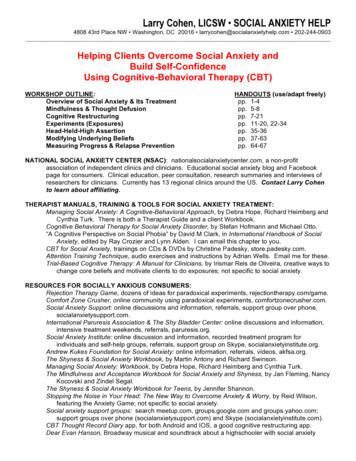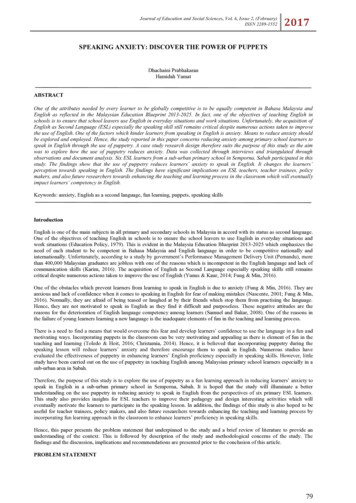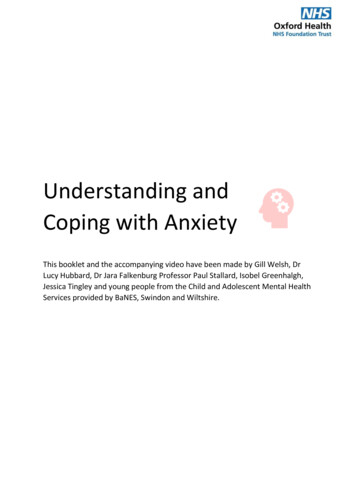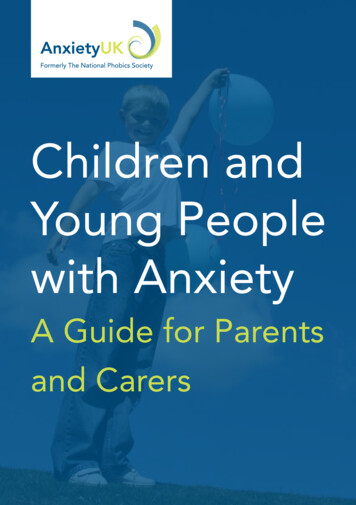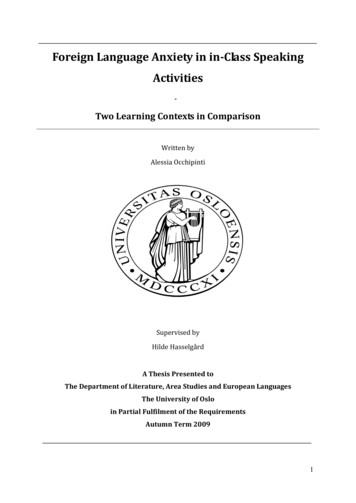
Transcription
Foreign Language Anxiety in in-Class SpeakingActivities-Two Learning Contexts in ComparisonWritten byAlessia OcchipintiSupervised byHilde HasselgårdA Thesis Presented toThe Department of Literature, Area Studies and European LanguagesThe University of Osloin Partial Fulfilment of the RequirementsAutumn Term 20091
AcknowledgmentsWriting this thesis has been a pleasurable process. I am grateful tomy supervisor Hilde Hasselgård for her good advice andinvaluable help throughout the process of writing this thesis, tothe University of Oslo and to the University of Cardiff for usefulinformation. I thank my family, mum, dad and Johannes for thecontinuous support they offered.University of Oslo, October 30, 20092
Table of contents1. Introduction 61.1 Motivation 72. Theoretical background 92.1 Foreign Language Anxiety 92.1.1 Foreign Language Anxiety in early studies .112.1.2 Debilitating and Facilitating Anxiety .122.1.3 Foreign Language Anxiety in later studies .132.1.4 Different perspectives: Trait, State and Situation Specific Anxiety .142.1.5 Components and sources of Foreign Language Anxiety .162.1.5.1 Communication Apprehension .172.1.5.2 Test Anxiety .192.1.5.3 Fear of Negative Evaluation .202.2 Speaking Anxiety in the L2 classroom .232.2.1 Introduction 232.2.2 Sources of speaking anxiety in the L2 classroom .242.2.2.1 Gender 252.2.2.2 Negative self perception and low self esteem .262.2.2.3 Competitiveness 282.2.2.4 Attitudes toward the L2 292.2.2.5 Negative experiences .302.2.2.6 Fear of taking risks .332.2.2.7 Students’ beliefs .342.2.2.8 Exposure variables and “time abroad” 372.2.2.9 In-Class activities 392.2.3 Manifestations of anxiety .412.2.4 Solutions .453
3. Methodology . 503.1 Sample of students .503.2 Questionnaire 513.3 Limitations .523.4 Results: Data Analysis Procedures .534. Results .554.1 In-Class activities 554.2 Speaking-Oriented in-Class Activities .634.2.1 Overview .634.2.2 Activity task .634.2.3 Speaking errors 694.3 Students’ self perception and speaking anxiety . 714.4 Interest in the English language .734.5 Students ‘beliefs .744.6 Anxiety-reducing characteristics of the instructor . .765. Summary and Conclusions .795.1 Summary .795.2 Conclusions .81Bibliography .83Appendix .96TABLE I 96TABLE II .97TABLE III .98Results’ TablesTable 1.1 In-Class Activities Arranged by Anxiety Level Means in Italy .99Table 1.2 In-Class Activities arranged by Anxiety Level Means in Great Britain .100Table 1.3 Anxiety Level basing on Means 101Table 1.4 In-Class Activities arranged by Self-Exposure requirement .102- 103Table 1.5 Anxiety Level, among Males and Females, based on In-Class Activities.104Table 2.1 Questionnaire Items and Student Responses to In-Class Activities Based onPercentage .105- 1064
Table 2.2 Questionnaire Items and Student Responses to In-Class Activities Based onMeans .107Table A Amxiety Level in Italy and Great Britain based on Table 2.2 Means .108Table 3.1 Students self evaluation of oral English competence .108Table 3.2 Gender in relationwith students self perceptions of their own oral EnglishCompetence .109Table 3.3 Students self perceptions in relation with students level of anxiety .109Table 4.1 How much do you rate your like for the English langauge?.109Table 4.2 Interest for English and speaking anxiety organized by Means .110Table 5.1 “Living for a while in the foreign language country has been helping/ wouldhelp me to improve my English language skills” .110Table 6.1 “Have you ever thought about embarrassment” in speaking English as a feelingthat many students may experience?.110Table 6.2 “Have you ever thought about embarrassment” in speaking English as a feelingthat many students may experience?.111Table 7.1 Instructor s characteristics .1125
1. Introduction“Speaking in the foreign language is often cited by students as their most anxietyproducing experience” (Young 1990: 539) and also “difficulty in speaking in class is probablythe most frequently cited concern of the anxious foreign language students seeking help at theLsc 1” (Horwitz et al. 1986: 126).Starting from the concept that a foreign language process is an activity which goes beyondthe mere memorization of linguistic structures, words and rules, the main intent of the presentstudy is the description of foreign language learning as a process which affects directly theemotional sphere of a student. This involves the learner and his personality, emotions andexperiences, all facets which in turn determine positive or negative attitudes toward thelanguage studied or the practices used to learn it. In an attempt to establish to what extentspeaking English in class is an activity feared by the students of this survey, I will describethe specific variables which contribute to arouse this feeling. Furthermore, recommendationswill be provided to teachers and students in order to prevent or alleviate these worries.Observing 100 Italian and Spanish university students of the English language, the studyfocuses on the main exposure variable of “time abroad” (i.e. in the foreign languageenvironment) spent by L2 2 students. For this reason, on the one hand it examines a sample offorty-five Italian university students learning English in Italy (i.e. in this case the Englishclassroom was the main opportunity to be exposed to the L2) and on the other hand it analysesa group of fifty-five university–level Spanish Erasmus subjects, studying English in GreatBritain, a country where English is the source language.Does living in the L2 country contribute to heighten the sense of ease felt at the momentof speaking the foreign language in class?A questionnaire was used based on Young’s questionnaire (1990) of sources of anxietyover L2 speaking. This provided an opportunity of measuring students’ anxiety during certainin-class practices as well as analysing their opinions about teachers’ behaviours andcharacteristics which might contribute to creating a comfortable environment in the foreignlanguage class. In order to investigate more deeply into learners’ personality aspects, somebackground questions were added, regarding students’ gender, self-perception and interest inthe English language. Moreover, the survey has turned out to be qualitative to some extent as1LSC is the Learning Skill Centre at the University of Texas.“Foreign” language is not intended to be in contrast with “second” language. Wherever a person is learning alanguage as a result of living in the country where it is spoken, or learning it with an instructor in a classroom,we will use the term “foreign” language learning.26
the students were asked to explicitly write and describe their feelings when they are in thesituation of speaking English in front of the class.The present work is organized as follows: a detailed description of Foreign LanguageAnxiety among students is first given, gradually moving towards the problem of speakinganxiety in the classroom. Reading through the existing literature on this area of linguistics hasbeen indispensable to me in order to shape the actual form of this research and to build thestructure and contents of the questionnaire administrated to the students. Students’ anxietywill be analysed in its components, symptoms and effects, as it resulted from the theoryresearch and from the students’ perspectives.The results show that in-class speaking activities are fairly stressful practices for thestudents surveyed in the present research. Reasons for this fear might be attributed to theanxiety about being “over- exposed” in front of others (communicative apprehension), fear ofmaking mistakes which may threaten the students’ self-esteem or harsh methods of theinstructor for correcting errors. Interestingly and in contrast to my expectations, the speakinganxiety levels of Italian students of English in Italy and Spanish students of English in GreatBritain were approximately the same, possibly because of the limited number of the classesobserved, inevitably too closely linked to the teaching methodologies of those teachers andthe general environment in those two particular classes.However, as the students’ comments about the instructors’ attitudes in the L2 are veryclear and homogenous in the groups, they may provide good advice to any person involved ina teaching activity. Being friendly, with a good sense of humour, by giving the possibility towork in small groups and to practice the foreign language are activities that make learnerscomfortable and more willing to participate. Students and teachers should be aware of thepossibility of the existence of such a debilitating feeling and should be open to constantcollaborations in order to put learners in a more positive condition to take all the advantagesfrom the foreign language learning process. And it needs to be remembered that it is acomplex phenomenon, but one that is useful and enjoyable for many people.1.1 MotivationThe reason for choosing this topic have been suggested by my personal experience as anItalian student of the English language in three different countries.I started studying in Italy, in Ragusa, a small town where the exposure to English is a rareevent except for some contexts (e.g. English language courses at school or University). Then Imoved to Norway, to Oslo, in order to attend an English language Master. Norway is a7
country in which English may be considered a semi-official language, present in manyworking sectors, on television (i.e. high occurrence of movies in British3or AmericanEnglish, the presence of several American TV programs). If they find themselves in thesituation of communicating in English, many Norwegians try to communicate in this languageeven if they do so with some difficulties. These were all aspects that, in my case, made a bigdifference in terms of English language exposure, compared to my Italian experience. As aMaster student of the English language in Norway I was fully aware of my limited knowledgeof English compared to my Norwegian classmates.I would ask: if you have ever been to Italy, how many Italians have you met speakingEnglish fluently? I am fairly sure that when you met one, you were quite surprised.What I experienced in Italy is that only a few people have a good knowledge of English,and even if they have it because they studied this language at school or university, they preferusing Italian. From my point of view, the reason for this behaviour is unclear. Probably itmight be due to the proud character of Italians and Latin people in general, which makes themunwilling to expose themselves and reveal possible weaknesses or mistakes in social contextseven when interacting with foreigners in a foreign language.As for myself, I felt the same discomfort. When I was in Italy and I had to speak Englishwith foreigners or people more competent than myself in the language (i.e. with my teacher inmy English language classroom) I felt insecure and very embarrassed. I was conscious of myweaknesses in the field of grammar and vocabulary and the fact of not being used topronouncing sounds different from the Italian ones made me very nervous.After my experience in Norway, I studied for one year in Great Britain as an Erasmusstudent. During this academic year, I was exposed to English language every day both atuniversity and in my daily life, thus in formal and informal situations. Being in contact withnative speakers, listening to radio and watching TV indeed helped me develop my Englishlanguage skills and make me feel more confident when the moment came to speak English inthe classroom. I felt rather relaxed and inclined to risk more, using the new words andexpressions I heard from my British friends, and I even tried to imitate English speakers’intonation and pronunciation.3Aware of the distinction that several researchers (Tottie, 2002; Algeo, 1988) have made between British andAmerican English, in the following research I will retain the exposure to British and American languagesindistinctly as an efficient tool to improve English language skills.8
Consequently, I became interested in finding out whether other students of English as asecond language, both in Italy and in Great Britain (i.e., the target language country, in thiscase) experienced the same feelings and fears when speaking in class.Is living in the L2 environment a predictor for the anxiety felt by students at the moment ofspeaking in the foreign language class? Which are the factors that produce this feeling?Which are the in class speaking activities which provoke anxiety in students? Such questionswill be the main concerns of the present research.9
2. Theoretical backgroundThe purpose of the present chapter is to introduce the reader to the wide area of foreignlanguage anxiety research by explaining some of the fundamental concepts which constitutethis field. Focusing in particular on foreign language speaking anxiety, numerous studies willbe mentioned and even quoted as solid guidelines to the interpretation of the structure of thepresent study as well as of the method I have adopted. Analysing other researchers’ findingshas been essential to select the relevant questionnaire used in order to gauge the students’level of speaking anxiety. Moreover these have constituted good terms for comparison withthe results of this survey.2.1 Foreign Language AnxietyThe increasing cross-cultural relations among individuals in society create a need forpeople to communicate in languages different from their native tongue. Due to reasons suchas business or the mere interest in a foreign culture the need to learn how to speak an L2fluently, correctly and even in a short time is evident. As globalisation increases, people inmost nations find themselves in the situation of speaking in front of others in an L2.However, speaking in the foreign language, both in social and academic contexts, entailsrisk taking and seems to be a challenging activity, in which learners who are not fluent in thetarget language experience that they cannot fully express their personality, or theirintelligence. Learners attempting to learn a foreign language have difficulties in relating toothers, experiencing in some cases a sense of alienation or “cultural shocks” (Crookal &Oxford, 1991: 142).For this reason the need for a systematic study of how people acquire a foreign languagehas arisen with origins in the second half of the 20th century.Researchers have consistently described learning a foreign language as a complex process,which implies the study of a new grammar, pronunciation, memorization of new words; butfirst and foremost it tests the learner’s ability in terms of his flexibility to take risks andmaking mistakes in front of other people. Over the years, the factors characterizing suchprocesses have been clearly outlined: these factors may be strictly linguistic (e.g. grammar,syntax) or extra-linguistic such as socio-contextual (Schuman, 1978), the input received bythe learner (Krashen, 1985).Learners differ, in fact, along a series of parameters such as age (Lennberg, 1971), mothertongue, general ability, affective factors like motivation and anxiety (Kleinmann, 1977; Ely,10
1986; Horwitz, Horwitz & Cope, 1986; MacIntyre & Gardner, 1991a; Price, 1991; Phillips,1992; Aida, 1994). Many investigators have been focusing on this latter aspect, trying todetermine the causes and effects which this has on learners (Chastain, 1975; Phillips, 1992;MacIntyre & Gardner, 1994; Bailey & Nunan, 1996).Attention has been drawn to the feelings of the students during their foreign languagelectures. “I just know I have some kind of disability: I can’t learn a foreign language nomatter how hard I try” (Horwitz et al. 1986: 125) and also “I think my English level is not sogood, so I am shy to talk English I hate English very much because I think English is quitedifficult to learn ” (Tsui, 1996: 145) are statements familiar to many foreign languagestudents and teachers. Hence, for many researchers, one of the prerogatives has been thenecessity to find teaching techniques and methods which help to lessen eventual feelings oftension (Krashen & Terrel, 1983; Crookall & Oxford, 1991; Young, 1991). It is important, infact, that the instructor begins exploring instructional strategies that may overcome thestudent’s feeling of inadequacy, confusion, and failure. High levels of anxiety maycompromise negatively the forthcoming attitude toward the foreign language studied.Teachers should strengthen students’ self esteem in their L2 ability via reassurance, empathyand even by encouraging realistic expectations regarding the time during which fluency in thetarget language may be acquired.As confirmed by several surveys (Horwitz et al., 1986; Ely, 1986; Young, 1990; Price,1991; Aida, 1994), one of the most anxiety-provoking activities in the foreign language isspeaking. Unlike writing, where “[ ] each writer can get on by himself, without disturbingthe rest of the class, at his own speed.” (Brown & Yule, 1983: 25) speaking is an activitywhich involves more than one person, and it tends to threaten one’s public standing fairlyeasily (Tsui, 1996).Intrinsic factors of speaking are intonation, pronunciation, fluency, all of which areabsolutely important for many foreign language students. As Moore (1977: 107) has pointedout “[ ] incorrect pronunciation, together with faulty speech melody and rhythm,immediately marks one as a foreigner.”2.1.1 Foreign Language Anxiety in early studiesDue to its emotional and psychological nature, foreign language anxiety was not easy toanalyse in early studies. Studies conducted in the 1970s were, in fact, difficult to interpretbecause of inconsistent findings. At that time, Scovel (1978) in his attempt to clarify theavailable literature on anxiety and language acquisition pointed out the contradictory11
conclusions which the other investigators were reporting. Probably due to the lack of adequatedefinitions and appropriate instruments used to measure anxiety 4, it was hard to establish aclear-cut relationship between anxiety and overall foreign language achievement.On the one hand, some investigators found positive correlations between foreign languageanxiety and proficiency (Chastain, 1975; Kleinmann, 1977; Scovel, 1978). Kleinmann, in hisstudy observed the behaviour of avoidance of certain English syntactic structures, using twogroups of ESL 5 students: a group of native speakers of Spanish and Portuguese and one ofnative speakers of Arabic. He found out that students who experienced high level of“facilitating anxiety” tended to use those English structures which their native language peersavoided instead (e.g. the use of English passive forms by the Arabic student group).On the other hand, negative connections were discovered (Chastain, 1975; Gardner,Smythe, Clement & Gliksman, 1976; McCoy, 1979; Lucas, 1984; Foss & Reitzel, 1988).Gardner et al. (1976) referring to what they termed “French Classroom Anxiety” describedthe debilitating effects of anxiety on an oral production test of Speech Skills. Hence, theyclaimed that, “[ ] the most anxious students are less proficient in Speech Skills” (quoted inBailey 1983: 68).Surprisingly, even unstable or a total lack of relationships were identified between anxietyand Speech Skills (Hamayan, Genesee & Tucker, 1976; Swain & Burnaby, 1976). Swain andBurnaby, surveying a group of English children attending a full immersion of French, found anegative correlation between anxiety and one measure of the children’s proficiency of French,but found no connections with any other proficiency measures.2.1.2 Debilitating and Facilitating AnxietyTwo interesting definitions of anxiety have been given throughout the investigations. Thefirst one, termed facilitating anxiety, is described as the positive force which may lead thestudent to become even more motivated for language learning. In this case, the subject dealswith the task in a more rational way, attempting more interpretive messages. Alpert & Haber(1960) wrote an important paper in which the key point was the “description of a newachievement-anxiety scale which has been devised to indicate not only the presence of orabsence of anxiety, but whether the anxiety facilitates or debilitates test performance” (Alpert4“[ ] anxiety in itself is neither a simple nor a well understood psychological construct it is perhapspremature to attempt to relate it to the global and comprehensive task of language acquisition.” (Scovel 1978:132).5ESL: English as a Second Language.12
& Haber, 1960: 207). Not all language researchers will term this feeling “anxiety”. Terrell, forexample, prefers calling it “attention” (Young, 1992).By contrast, debilitating anxiety motivates the learner to withdraw from the language taskand leads him to adopt avoidance behaviours (Alpert & Haber, 1960; Scovel, 1978).According to Horwitz et al. (1986), highly anxious students avoid conveying complexmessages in the foreign language, or take more time to learn vocabulary items (MacIntyre &Gardner, 1989). In addition, though anxious students tend to over study, their course gradesoften do not reflect that effort (Price, 1991). The present study will focus solely ondebilitating anxiety.2.1.3 Foreign Language Anxiety in later studiesDespite the discrepant perspectives reported above, almost all studies nowadays describeanxiety as an affective factor which mainly has a stable, negative impact at all stages offoreign language learning and production (Horwitz et al., 1986; Tobias, 1986; Price 1991;MacIntyre & Gardner 1991a; Phillips 1992; Aida, 1994; Ellis, 1994; Cheng, Y., Horwitz, &Schallert, 1999). This might be due to the uniqueness of foreign language learning itself:students are required to acquire new linguistic rules and to perform in a language which theyare still trying to master. Hence the occurrence of frequent mistakes may put them invulnerable positions open to criticism and negative evaluations (Tsui, 1996: 155).Language learners develop a new way of perceiving themselves in terms of thinking andacting; they develop a new language ego which “can easily create a sense of fragility,defensiveness, and a raising of inhibitions” (Brown, 1994: 22). There may be a sort ofvariance between the “true” self as known to the language learner and the more restricted selfexperienced in any language learning situations. The learner may enter into a profoundlyunsettling psychosocial status which threatens his own sense of self and worldview (Guiora,1983 quoted in Horwitz et al. 1986: 125). Several learners may feel that as they speak an L2their own personality is reduced and even infantilized (Simensen, 2007).Steinberg & Horwitz (1986) affirm that persons who usually perceive themselves associable and reasonably intelligent may experience difficulties when they have tocommunicate even basic concepts in the foreign language. Therefore, evidence does indicatethat anxiety plays an important psychological role as language students are concerned.Campbell & Ortiz (1991: 159) consider the level of language anxiety to be “alarming”among university students. Along similar lines, Horwitz et al. (1986) and MacIntyre &Gardner (1991a) report that for many students the foreign language class may be the most13
anxiety provoking: nervous students may have difficulties in listening comprehension(Horwitz et al., 1986), may be less likely to answer as volunteers in oral activities (Ely, 1986;Tsui, 1996) and may over-study in an effort to alleviate their worries (Horwitz et al., 1986).2.1.4 Different perspectives: Trait, State and Situation Specific AnxietyOver the years, foreign language anxiety research has been conducted from differentpoints of views. On the one side investigators have attributed this tension to the generalpersonality of the subject and his way of behaving in various situations. On the other hand,the situation has been identified as being the cause for the students ‘anxiety. In this respect,three main approaches have been clearly outlined by MacIntyre & Gardner (1991b) in one oftheir papers. The first approach considers language anxiety as a “Trait Anxiety”. Initiallyidentified by Cattell & Scheier (1961, in Gaudry, Vagg & Spielberger, 1975), Trait Anxietywas later developed by Spielberger and his colleagues, in an attempt to measure it and toevaluate its possible relations with State Anxiety, an emotional state related to the here andnow experience. State Anxiety is a sense of uneasiness that may be experienced at a particularmoment in time, as a response to a definite situation, for example, prior to an examination(Spielberger, 1983). Devices to measure both Trait and State Anxiety were formulated: one ofthese is the State-Trait Anxiety Inventory (STAI) consisting of two 20-item self-report scales.Through the examination of Australian students attending high school and university, ithas been found that Trait Anxiety reflects the stable tendency of the person to respond withnervousness in any threatening situation. Subsequent studies (Young, 1990; MacIntyre &Gardner, 1991b) have confirmed such conceptualisation of trait anxiety. Spielberger (1983 inMacIntyre & Gardner, 1991b: 87) states that “Trait anxiety may be defined as an individual’slikelihood of becoming anxious in any situation.” adopting also avoidance behaviours(Eysenck 1979 in MacIntyre & Gardner, 1991b: 87). MacIntyre & Gardner (1991b: 87)describe this feeling as “general personality trait that is relevant across several situations”.The second type of perspective describes foreign language anxiety as “State Anxiety”.People with a high level of Trait Anxiety (i.e. people who are anxious in general) are usuallylikely to get an increase of State Anxiety.Last but not least, the third approach considers foreign language anxiety as a kind of“Situation Specific Anxiety” (Tobias, 1986; Young, 1991; Aida, 1994; Clement, Dornyei &Noels, 1994; Bailey & Nunan, 1996), originating from the occurrence of well-definedcircumstances. “Studying anxiety means studying the interaction of the person in the situationproducing that anxiety.” (Endler, 1980): for some persons, for example, sitting written14
examinations may be a stressful activity (Cheng, et al., 1999). For others, however, speakingin front of their peers in the classroom may cause a high level of anxiety (Price, 1991;Phillips, 1992).In the present survey, I will proceed from this latter perspective, by focusing on thespecific context of the classroom.In comparison with Trait and State anxiety, the Situation Specific approach has renderedthe most meaningful and consistent results and has the advantage of allowing investigators toprobe various aspects of foreign language learning. Respondents may be asked, for instance,to attribute anxiety to particular sources, like former negative experiences, or theirrelationship with the language teacher, or certain activities like being corrected in front of therest of the class (Young, 1990; Phillips, 1994), or answering as volunteers (Ely, 1986). Hencethere is a need to treat this kind of apprehension as a problem related to the area of didactics,language teaching, rather than general psychology. There is a need to elaborate teachingapproaches, practices, and materials that may help lessen the discomfort of students in theirprocess of learning a foreign language (Koch & Terrell, 1991; Phillips, 1999).Possible sources of anxiety in the foreign language classroom are reflected in thequestionnaires which many researchers have elaborated. Gardner et al. (1976), have found theexistence of what they called French Classroom Anxiety, based on self reports from onethousand high school students learning French. Subsequent studies have developed otherscales, as the English Use Anxiety (Clément et al., 1977) or the English Test Anxiety(Clément et al., 1980). Horwitz et al. (1986) developed the Foreign Language Anxiety Scale(FLCAS) in order to capture specific reactions of beginner learners of Spanish. In the latterstudy, particular attention was given to the situation of speaking, as an activity which mighteasily induce anxiety. Students endorsed statements such
forty-five Italian university students learning English in Italy (i.e. in this case the English classroom was the main opportunity to be exposed to the L2) and on the other hand it analyses a group of fifty-five university-level Spanish Erasmus subjects, studying English in Great Britain, a country where English is the source language.
